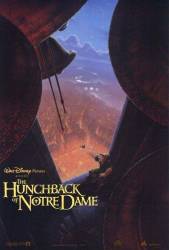Factual error: Towards the end of the song "Out There" Quasimodo climbs onto the large spire on the roof. That spire was added in the 19th century and thus didn't exist when the movie was set.
Factual error: During the song "A Guy Like You," one of the gargoyles trips the trapdoor on Quasimodo's miniature hangman's scaffold. Trapdoors weren't used on scaffolds until the 18th century.
Factual error: When Quasimodo and Esmerelda are on the roof of the cathedral, a piece of the roof breaks off and slides with them standing on it. The material creates sparks as it slides. The material would be either copper or (more likely) lead, neither of which can be made to spark.
Factual error: The statues outside of Notre Dame Cathedral are shown as plain stone, as they appear in modern times, although in the story's period (the fifteenth century) they were polychromed.
Factual error: After Phoebus distracts the guards to stop them from chasing Esmeralda, we see the goat smoking a pipe to give the appearance of a beggar. Tobacco (and consequently, smoking pipe) wasn't introduced in Europe for at least another century, as it's a plant native to the Americas.
Factual error: At one point, Quasimodo says, "At sunset, I ring the evening mass, and after that, I clean the cloisters, and then I ring the vespers, and..." In fact, evening masses were not permitted by the church until the twentieth century.






Answer: It was most certainly sexual. Frollo's whole arc was his fight against his carnal desires (seeing Esmerelda dancing in the fire, sniffing her hair, etc). In order to maintain a G-rating, they couldn't be overtly sexual, which is why it's done through suggestion and subtext.
JC Fernandez